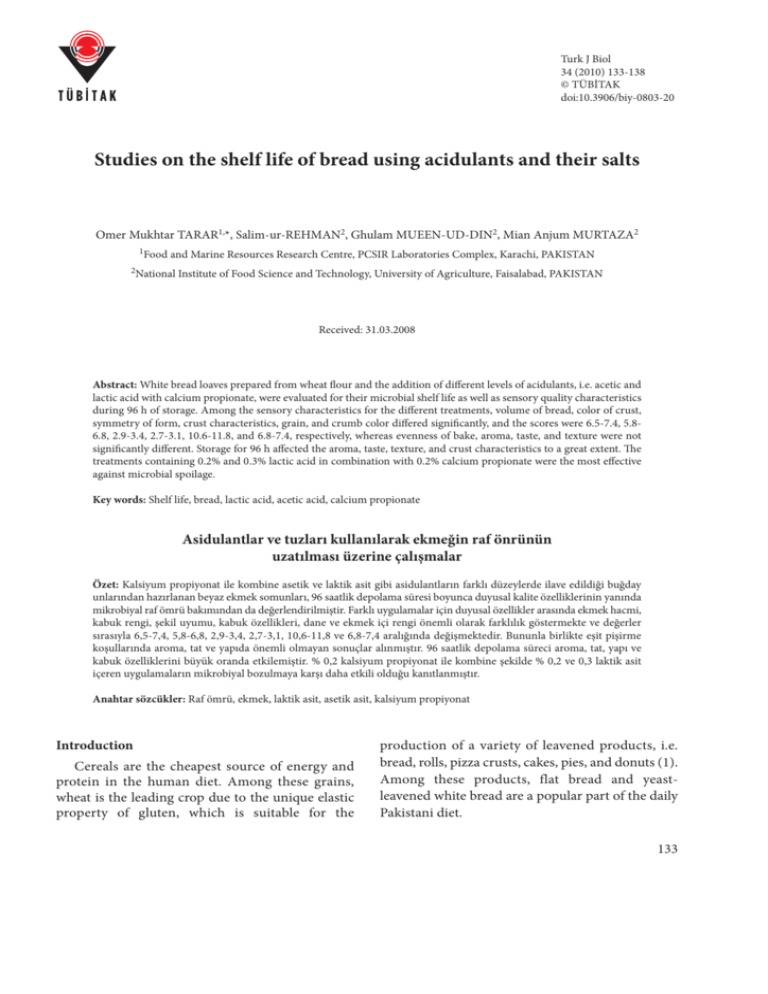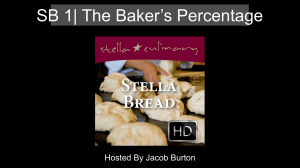Studies on the shelf life of bread using acidulants and their salts
advertisement

Turk J Biol 34 (2010) 133-138 © TÜBİTAK doi:10.3906/biy-0803-20 Studies on the shelf life of bread using acidulants and their salts Omer Mukhtar TARAR1,*, Salim-ur-REHMAN2, Ghulam MUEEN-UD-DIN2, Mian Anjum MURTAZA2 1 Food and Marine Resources Research Centre, PCSIR Laboratories Complex, Karachi, PAKISTAN 2National Institute of Food Science and Technology, University of Agriculture, Faisalabad, PAKISTAN Received: 31.03.2008 Abstract: White bread loaves prepared from wheat flour and the addition of different levels of acidulants, i.e. acetic and lactic acid with calcium propionate, were evaluated for their microbial shelf life as well as sensory quality characteristics during 96 h of storage. Among the sensory characteristics for the different treatments, volume of bread, color of crust, symmetry of form, crust characteristics, grain, and crumb color differed significantly, and the scores were 6.5-7.4, 5.86.8, 2.9-3.4, 2.7-3.1, 10.6-11.8, and 6.8-7.4, respectively, whereas evenness of bake, aroma, taste, and texture were not significantly different. Storage for 96 h affected the aroma, taste, texture, and crust characteristics to a great extent. The treatments containing 0.2% and 0.3% lactic acid in combination with 0.2% calcium propionate were the most effective against microbial spoilage. Key words: Shelf life, bread, lactic acid, acetic acid, calcium propionate Asidulantlar ve tuzları kullanılarak ekmeğin raf önrünün uzatılması üzerine çalışmalar Özet: Kalsiyum propiyonat ile kombine asetik ve laktik asit gibi asidulantların farklı düzeylerde ilave edildiği buğday unlarından hazırlanan beyaz ekmek somunları, 96 saatlik depolama süresi boyunca duyusal kalite özelliklerinin yanında mikrobiyal raf ömrü bakımından da değerlendirilmiştir. Farklı uygulamalar için duyusal özellikler arasında ekmek hacmi, kabuk rengi, şekil uyumu, kabuk özellikleri, dane ve ekmek içi rengi önemli olarak farklılık göstermekte ve değerler sırasıyla 6,5-7,4, 5,8-6,8, 2,9-3,4, 2,7-3,1, 10,6-11,8 ve 6,8-7,4 aralığında değişmektedir. Bununla birlikte eşit pişirme koşullarında aroma, tat ve yapıda önemli olmayan sonuçlar alınmıştır. 96 saatlik depolama süreci aroma, tat, yapı ve kabuk özelliklerini büyük oranda etkilemiştir. % 0,2 kalsiyum propiyonat ile kombine şekilde % 0,2 ve 0,3 laktik asit içeren uygulamaların mikrobiyal bozulmaya karşı daha etkili olduğu kanıtlanmıştır. Anahtar sözcükler: Raf ömrü, ekmek, laktik asit, asetik asit, kalsiyum propiyonat Introduction Cereals are the cheapest source of energy and protein in the human diet. Among these grains, wheat is the leading crop due to the unique elastic property of gluten, which is suitable for the production of a variety of leavened products, i.e. bread, rolls, pizza crusts, cakes, pies, and donuts (1). Among these products, flat bread and yeastleavened white bread are a popular part of the daily Pakistani diet. 133 Studies on the shelf life of bread using acidulants and their salts With respect to the longevity of commercial white bread’s storage, ways and means should be explored to extend its shelf life. The basic criteria for the quality of bakery products are health safety and optimum sensory properties. The durability of bakery products with medium and high humidity content is often limited by the growth of molds (2). Losses caused by the growth of mold vary between 1% and 5%, depending on the season, the type of product, and the mode of production (3). At present, breads often spoil within 48 h of production, causing significant loss to the producers. Other major types of microbial spoilage of baked bread are usually moldiness and ropiness. A number of mold species of Aspergillus, Rhizopus, Cladosporium, Penicillium, and Fusarium (4) are thought to be responsible for such moldiness, whereas ropiness is caused by Bacillus subtilus or B. licheniformis (5). Microbial species can be controlled by improving sanitary conditions at bakeries, whereas incorporation of different acids and their salts in bread formulations provide the baker protection against rapid mold and bacterial spoilage. The selection of acidulants and their salts, i.e. sorbic acid, benzoic acid (6), and propionic acid, and their salts (7) as preservatives and pH (8,9) are among the most crucial factors influencing the microbial and sensory quality of bakery products. The objective of the present study was to evaluate the effectiveness of various combinations and concentrations of lactic acid and acetic acid with the calcium salt of propionic acid in the prevention of bread spoilage, and to determine the sensory quality attributes at various storage intervals. Materials and methods Raw materials Flour and other ingredients, i.e. sugar, salt, shortening, and yeast, were purchased from a local market. Acetic acid, lactic acid, and calcium propionate were procured from a scientific store. Proximate analysis The flour was analyzed for its moisture, total ash, crude fat, crude protein (10), and crude fiber (11) content. Farinographic studies The flour sample was run through a Brabender farinograph equipped with a 50-g capacity bowl to assess the physical behavior of the flour, according to the AACC method 54-21 (12). Preparation of bread The bread was prepared from straight grade flour, according to AACC method 10-09 (12). The experimental bread ingredients were flour (1000 g), sugar (60 g), salt (20 g), oil (40 g), yeast (12 g), bread improver (7 g), water (adjusted as necessary from that determined by the farinograph), and a preservative combination (Table 1). Sensory evaluation Sensory evaluation of the bread—external and internal characteristics at 3, 24, 48, 72, and 96 h of bread storage—was performed by a panel of 5 judges, as described by Land and Shepherd (13). Table 1. Description of treatments. 134 Treatments Calcium Propionate (%) Acetic acid (%) Lactic acid (%) T0 (Control) T1 T2 T3 T4 T5 T6 0.20 0.20 0.20 0.20 0.20 0.20 0.20 0.20 0.30 0.40 - 0.20 0.30 0.40 O. M. TARAR, S. REHMAN, G. MUEEN-UD-DIN, M. A. MURTAZA Microbial examination Counting and identification of molds in bread after 3, 24, 48, 72, and 96 h of storage were performed by the agar plate technique method on Sabouraud agar medium (14), whereas counting and identification of bacteria were performed on nutrient agar medium using the plate count method (15). Statistical analysis Data obtained for the different parameters were subjected to statistical analysis using the analysis of variance (ANOVA) technique and the least significance difference (LSD) test was used to compare the means, according to the procedure described by Steel et al. (16). Results and discussion Wheat flour analysis of its proximate constituents and the farinographic study results are presented in Table 2. High water absorption, as well as flour with improved baking quality, was observed. The data show that the flour contained a high level of good quality protein, based on the dough stability time (10.45 min). Kandhari (17) observed a similar relationship between flour quality and baking characteristics. Statistical analysis of the sensory evaluation data shows that various parameters were subjected to change due to the influence of different levels of preservative, as well as storage intervals (Figures 1 and 2). It was observed that as the quantity of acid increased in the bread dough there was a slight decrease in the volume of bread. Bread volume was the lowest at the maximum acetic acid level (T3), i.e. 6.520. These results are in agreement those of Nawab et al. (18). Seguchi et al. (19) explained the effect of gaseous acetic acid on bread making properties and observed that increasing acetic acid could reduce bread volume. Yeast activity generally decreased as a function of increasing antimicrobial concentrations. At in situ concentrations, calcium propionate resulted in the greatest reduction in yeast activity, followed by acetic acid and then lactic acid (20). A dough fermentometer test was used to measure baker’s yeast activity in the presence of these natural antimicrobials and calcium propionate. Table 2. Analytical and farinographic data for the flour sample. Proximate composition of flour Farinographic characteristics of flour Moisture Protein Ash Fat Crude fiber Water Absorption Mean score 12.60% 9.78% 0.40% 1.10% 0.69% 18 16 14 12 10 8 6 4 2 0 3 h. 24 h. Crust character 66.8% Dough Development Time Dough Stability Time 48 h. Aroma 72 h. 9.8 min 10.5 min 96 h. Taste Texture Sensory atributes Figure 1. Effect of storage time on sensory characteristics of bread. 135 Studies on the shelf life of bread using acidulants and their salts 14 Sensory score 12 T0 T1 T2 T3 T4 T5 T6 10 8 6 4 2 0 Color of Crumb Grain Crust Character Volume Colour of Crust Symmetry of Form Sensory atributes Figure 2. Effect of treatments on sensory characteristics of brea. The lactic acid combinations T4, T5, and T6 produced the highest mean values (between 7.440, 7.360, and 7.340) for crumb color, while the control treatment (T0) produced the lowest (6.820), along with the acetic acid combinations. Different treatments affected the character of crust significantly, as the best value was obtained with T5 (3.080), followed by T2, T6, T4, and T3, respectively, with values (3.000, 2.940, 2.960, and 2.880, respectively) that were not significantly different, whereas T0 and T1 resulted in the lowest values. It is obvious from Table 3 that storage time also affected the character of crust. The best results were observed at 3 h (3.100), with a declining pace, whereas the storage results at 96 h (2.829) were the least acceptable. The analysis of variance for treatments was significant for grain formation. The mean value for T1 (11.84) was the highest. Storage had no effect on grain. In terms of crust color, the lowest mean score was obtained with treatment T3 (5.860), whereas the highest mean score was achieved with T5 (6.860). The result for symmetry of form indicated that the lactic acid combinations produced the best mean scores; 3.400, 3.220, and 3.100 for T5, T4, and T6, respectively. This acid has a growth-stimulating effect on yeast. Pyler (5) reported similar results. Although the effects of various treatments on aroma, taste, and texture were not significant, Gonkarov and Skalov (21) observed improvement in bread aroma when acidulants were used for the preservation of bread. These characteristics deteriorated significantly during storage. 136 As storage time increased the taste of the bread became more unacceptable, as the lowest mean value was obtained at 96 h of storage (13.86). Bread aroma and texture also deteriorated with time: mean values at 96 h of storage time were the lowest—6.257 and 10.39, respectively. Volatile and nonvolatile compound contents of the bread showed certain variations that correlated with the flavor scores. In general, the alcohol, ketone, and salt content are considered to positively affect the evaluation of wheat bread flavor, whereas the aldehyde and acid content, including lactic acid, have negative effects (22). Evenness of bake was not affected during storage and did not vary significantly according to treatment. It is obvious from Table 4, which shows the mold count at different time intervals, that treatment T6 was the most effective for controlling fungal growth. Fungal growth appeared after 48 h of storage; however, there was no additional growth or appearance of fungi with this treatment, until yeast colonies were recorded at 96 h of storage at the rate of 3 1.1 × 10 CFU/g. The maximum number of viable fungal colonies was recorded in the control treatment T0, while different combinations of lactic acid with calcium propionate exhibited more effective protection against fungi, followed by treatments with acetic acid. These results agree with those of Branen et al. (23). The majority of molds isolated from these studies belong to Arpergillus flavus, followed by A. fumigatus, Penicillium spp., Rhyizopus, and Mucor. Latif et al. (24) also studied different genera of molds (Aspergillus, Penicillium, and Actinomycetes) in bread. O. M. TARAR, S. REHMAN, G. MUEEN-UD-DIN, M. A. MURTAZA Table 3. Bacterial count at different storage times. T0 T1 T2 T3 T4 T5 T6 3h 24 h 48 h 72 h 96 h 3.0 × 102 - 1.7 × 103 2 × 102 3 × 102 2 × 102 6 × 102 3.7 × 103 2.9 × 103 7 × 102 3 × 102 - 4.9 × 103 1.9 × 103 11 × 102 5 × 102 5 × 102 9 × 102 1 × 103 6.7 × 103 3.6 × 103 7 × 102 1 × 102 1.9 × 103 1.3 × 103 7 × 102 Table 4. Mold count at different storage times. T0 T1 T2 T3 T4 T5 T6 3h 24 h 48 h 72 h 96 h 1.0 × 103 1.0 × 102 - 4.9 × 103 2.2 × 103 1.2 × 103 1.1 × 103 1.0 × 103 3.0 × 102 - 2.37 × 104 8.5 × 103 7.0 × 102 4.2 × 103 3.1 × 102 6.0 × 102 6.0 × 102 2.7 × 104 5.1 × 103 2.4 × 102 6.5 × 103 1.7 × 102 1.2 × 103 - 2.6 × 104 3.7 × 104 4.8 × 103 3.5 × 103 5.4 × 103 1.4 × 103 1.1 × 103 In the control treatment (T0) bread the number of bacterial colonies on nutrient agar medium was 3.6 × 103 after 96 h of storage (Table 3); however, the total bacterial count was too low to be reported in the majority of observations. Thus, acid combinations with calcium propionate adequately prevented bacterial growth in the bread. Sharma et al. (25) postulated that calcium propionate (0.5%) could improve the storage quality of flat bread. After 24 h of incubation on nutrient agar plate, Bacillus subtilis, Pseudomonas spp., and Staphylococcus spp. were present in the breads prepared with different preservative combinations. The predominant species isolated in wheat flour and ropy bread were Bacillus subtilis and B. licheniformis (26). Ten of the 15 strains of B. subtilis and 4 of the 6 strains of B. licheniformis caused rope spoilage in the laboratorybaked bread. Conclusions The results of the present study lead us to some conclusions regarding extending the shelf life and improving the sensory quality of bread. In order to achieve these goals strict implementation of hygiene and sanitation plans at production sites is required. The use of acidulants and their salts may be useful as well. It is therefore suggested that low lactic acid combinations (0.2% and 0.3%) could positively affect the quality characteristics of bread and provide better protection against microbial spoilage. Corresponding autor: Omer Mukhtar TARAR Food and Marine Resources Research Centre, PCSIR Laboratories Complex, Karachi, Pakistan E-mail: omertarar@yahoo.com 137 Studies on the shelf life of bread using acidulants and their salts References 1. Cornell HJ, Hoveling AW. Wheat Chemistry and Utilization. Technomic Publishing Co Inc. Lancaster; 1998. 15. Frazier WC, Foster EM. Laboratory Manual for Food Microbiology. Burgess Pub Co, Minneapolis, Minnesota; 1958. 2. Hozová B, Kukurová I, Turicová R et al. Sensory quality of stored croissant type bakery products. Czech J Food Sci 20(3): 105-112, 2002. 16. Steel RGD, Torrie JH, Dickey D. Principles and Procedures of Statistics - A Biometrical Approach. 3rd ed. McGraw Hill Book Co Inc. New York; 1997. 3. Vega MC, Martinez MC, Albisu M et al. Un problema de conservacion en productos de bolleria en fase de comercializacion. Alimentaria 292: 77-80, 1998. 17. Kandhari LR. Bakers Hand book on Practical Baking. Wheat Associates. Delhi; 1979. 18. 4. Chakre DS, Patil PL, Patil BC. A study of bread spoilage and its control. J Mahashastra Agric Univ 91:81-83, 1984. Nawab K, Zaman R, Ehtesham-ud-din AFN. Studies on bread preservation for summer season. Pak J Sci Ind Res 32(11): 772774, 1989. 5. Pyler EJ. Baking Science and Technology. Sosland Publishing Co. Kansas; 1988: p 219. 19. 6. Frias I, Alvarez R, Sierra A et al. Aspectos bromatologicos y toxicologicos de los conservantes benzoico y sorbico. Alimentaria 6: 109-114, 1996. Seguchi M, Hayashi M, Matsumoto H. Effect of gaseous acetic acid on dough rheological and bread making properties. Cereal Chem 74(2): 129-134, 1997. 20. Roslyakov YF, Palagina IA. Physiochemical features of propionic acid as a preservative. Pishchev Tekhnol 5/6: 31-34, 1996. Pattison TL, von Holy A. Effect of selected natural antimicrobials on Baker’s yeast activity. Lett Appl Micr 33(3): 211-215, 2001. 21. Goncharov MD, Skalov PI. Application of amylolitic lactic acid bacteria to prevent ropiness of bread. Khlebopekarnaya I Konditerskaya Promyshlennost 3: 32-34, 1977. 22. Quílez J, Ruiz JA, Romero MP. Relationships between sensory flavor evaluation and volatile and nonvolatile compounds in commercial wheat bread type baguette. J Food Sci 71(6): S423S427, 2006. 23. Branen AL, Davidson PM, Salminen S. Food Additives. Marcel Dekker Inc. New York; 1980. 24. Latif A, Masood T, Khan HA et al. Quality improvement and shelf life extension of bread. J Agric Soc Sci 1(2): 109-113, 2005. 25. Sharma S, Sekhon KS, Nagi HPS. Sensory characteristics and storage quality of flat bread from Indian wheats. Chem Mikrobiol Technol Lebensm 17(5-6): 156-160, 1995. 26. Sorokulova IB, Reva ON, Smirnov VV et al. Genetic diversity and involvement in bread spoilage of Bacillus strains isolated from flour and ropy bread. Lett Appl Micr 37(2): 169-173, 2003. 7. 8. Šilhánková L. Mikrobiologie pro Potravináře a Biotechnology. Victoria Publishing. Praha; 1995. 9. Abellana M, Torres L, Sanchis V et al. Caracterizacion de diferentes productos de bolleria industrial II. Estudio de la micoflora. Alimentaria 287: 51-56, 1997. 10. Delwiche S. Cereal foods. In: Horwitz W. ed. Official Methods of Analysis of AOAC International. 18th ed, Assoc Off Anal Chem. Washington DC; 2005: pp.1-61. 11. Hart FL, Fisher HJ. Modern Food Analysis. Springer-Verlag Inc. New York; 1981: pp 22-23. 12. AACC. Approved Methods of American Association of Cereal Chemists. 10th ed, Am Assoc Cereal Chem Inc. St Paul; 2008. 13. Land DG, Shepherd R. Scaling and ranking methods. In: Piggot JR. ed. Sensory Analysis of Foods. Elsevier App Sci Pub. New York; 1988: pp 155-185. 14. Beneke ES. Medical Mycology Lab Manual. Burgess Pub Co. Minneapolis, Minnesota; 1962. 138







